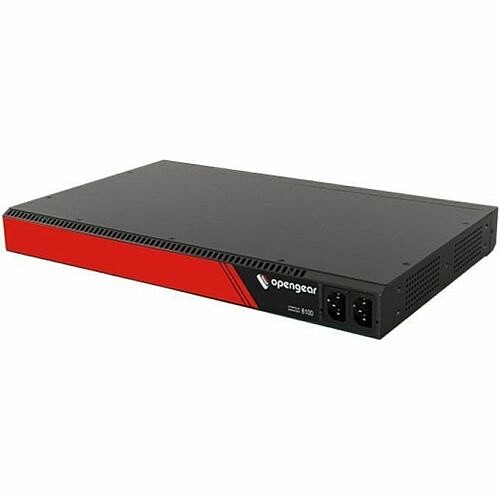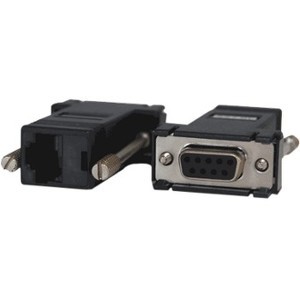Opengear CM8100 Console Server - 1.95 GB - DDR4 SDRAM - Twisted Pair - 2 x Network (RJ-45) - 2 x USB - 16 x Serial Port - 10/100/1000Base-T - 10 Gigabit Ethernet - Management Port - Rack-mountable CM8116-DDC
CM8116-DDC | Opengear®
Part Number: CM8116-DDC
Condition: New
In Stock:
Out of stock
Real time availability 
Notify Me
Product Specifications
Opengear CM8100 Console Server - 1.95 GB - DDR4 SDRAM - Twisted Pair - 2 x Network (RJ-45) - 2 x USB - 16 x Serial Port - 10/100/1000Base-T - 10 Gigabit Ethernet - Management Port - Rack-mountable CM8116-DDC
16SERIAL 2X1GBE ARM1.6GHZ2 COREWRLS - 2GBMEM32GB TPM2.0 DOCKER DUAL DC
Manufacturer Part Number: CM8116-DDC
MANUFACTURER NAME: Opengear
MANUFACTURER PART NUMBER: CM8116-DDC
UPC EAN CODE:
LANGUAGE: EN
MARKET:US
| General Information: | |
The CM8100 is Opengear's newest console manager for data centers and enterprise networks. Building on 18 years of Opengear product innovation and leadership, the CM8100 Console Manager provides up to 48 serial ports, enterprise-grade security using TPM 2.0 module, and independent monitoring using dual power supplies.
| |
| Manufacturer | Opengear |
| Manufacturer Part Number | CM8116DDC |
| Manufacturer Website Address | http://www.opengear.com |
| Brand Name | Opengear |
| Product Model | CM8116 |
| Product Name | CM8100 Console Server |
| Product Type | Device Server |
| Technical Information: | |
| Device Type | Console Server |
| Processor & Chipset: | |
| Processor Manufacturer | ARM |
| Processor Speed | 1.60 MHz |
| Memory: | |
| Standard Memory | 1.95 GB |
| Memory Technology | DDR4 SDRAM |
| Maximum Memory Supported | 32 GB |
| Media & Performance: | |
| Media Type Supported | Twisted Pair |
| Network & Communication: | |
| Ethernet Technology | 10 Gigabit Ethernet |
| Network Standard | 10/100/1000Base-T |
| Interfaces/Ports: | |
| Network (RJ-45) | Yes |
| USB | Yes |
| Serial Port | Yes |
| Management Port | Yes |
| Number of Network (RJ-45) Ports | 2 |
| Number of USB Ports | 2 |
| Number of Serial Ports | 16 |
| Power Description: | |
| Input Voltage | -40 V DC
72 V AC |
| Input Voltage Range | -40V DC to 72V DC |
| Physical Characteristics: | |
| Form Factor | Rack-mountable |
| Height | 1.8" |
| Width | 17.3" |
| Depth | 9.3" |
| Weight (Approximate) | 9.50 lb |
Questions and Answers
Questions and Answers | Ask CompSource |
Shipping / Returns
Shipping
Ground =
FREE
(Delivery within 2-7 business days)
Two Day Air = $42.00
(Delivery within 2 business days)
Standard One Day = $67.00
(Delivery within next business day)
Priority = $98.00
(Delivery within next business morning)
U.S Mail Priority (AA,AE,AP only) = $46.67
FedEx International Economy (Canada only) = $102.00
Typically out of stock items are filled within 1 to 14 business days but can and may take longer.
Shipping dates are best estimates based on product location and may vary with holidays.
If product requires trucking, additional fees may apply.
* Some destinations are subject to Applicable State/Duty Taxes
Returns
CompSource realizes that every product may have different return guidelines. Please see the policy below regarding this item.
This Product Has Limited Exchange Privileges.
Please call for return guidelines.
For support on this product, please contact Opengear.
Opengear Company's Information
Click Opengear for all products
Product Reviews
Overall Rating | Write a Review
|
|
Best Sellers
More Best Sellers
Learn more about Terminal & Device Servers
Switches, routers, and wireless access points
Switches, routers, and wireless access points perform very different functions in a network.
A computer network, or data network, is a digital telecommunications network which allows nodes to share resources. In computer networks, computing devices exchange data with each other using connections (data links) between nodes These data links are established over cable media such as wires or optic cables, or wireless media such as WiFi.Switches
Switches are the foundation of most business networks. A switch acts as a controller, connecting computers, printers, and servers to a network in a building or a campus.
Switches allow devices on your network to communicate with each other, as well as with other networks, creating a network of shared resources. Through information sharing and resource allocation, switches save money and increase productivity.
There are two basic types of switches to choose from as part of your networking basics: managed and unmanaged.
- An unmanaged switch works out of the box but can't be configured. Home-networking equipment typically offers unmanaged switches.
- A managed switch can be configured. You can monitor and adjust a managed switch locally or remotely, giving you greater control over network traffic and access.
Routers
Routers connect multiple networks together. They also connect computers on those networks to the Internet. Routers enable all networked computers to share a single Internet connection, which saves money.
A router acts a dispatcher. It analyzes data being sent across a network, chooses the best route for data to travel, and sends it on its way.
Routers connect your business to the world, protect information from security threats, and can even decide which computers receive priority over others.
Beyond those basic networking functions, routers come with additional features to make networking easier or more secure. Depending on your needs, for example, you can choose a router with a firewall, a virtual private network (VPN), or an Internet Protocol (IP) communications system.
Access points
An access point* allows devices to connect to the wireless network without cables. A wireless network makes it easy to bring new devices online and provides flexible support to mobile workers.
An access point acts like an amplifier for your network. While a router provides the bandwidth, an access point extends that bandwidth so that the network can support many devices, and those devices can access the network from farther away.
But an access point does more than simply extend Wi-Fi. It can also give useful data about the devices on the network, provide proactive security, and serve many other practical purposes.
*Access points support different IEEE standards. Each standard is an amendment that was ratified over time. The standards operate on varying frequencies, deliver different bandwidth, and support different numbers of channels.
Wireless networking
Wireless networking is a method by which homes, telecommunications networks and business installations avoid the costly process of introducing cables into a building, or as a connection between various equipment locations.CompSource will educate and help make this process enjoyable and easy.
Whether you're planning on using your network for basic home tasks or enterprise level security. You can tell our trained sales professionals your needs, and we’ll make custom recommendations to suit your specifications and budget. Our reps have extensive knowledge and love to share. We educate, not sell, CompSource makes sure you buy what you need and not waste money on what you don't. As with every decision we never push, it's up to you when, and if you make a purchase.
CompSource has a great technical staff that can help with a solution for your exact needs.
Chat with us or give our professionals a quick phone call (800)-413-7361.
The transaction went exactly the way it should. Very helpful staff and one of the few companies I could find with inventory and willing to do an international shipment. I will buy again from them !!! AnonymousMore Reviews























